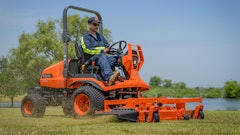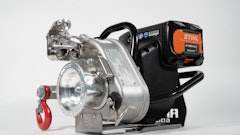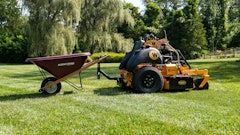
As the benefits of lower emissions, quieter operation and fewer maintenance costs add up, battery power continues to gain traction within the green industry—whether for handheld equipment, mowers or even larger compact machines.
“In many places, sustainability is being built into job requirements or laws, so it’s smart to be ready for these changes sooner rather than later,” says Lars Arnold, product manager, sustainable power, Volvo Construction Equipment. “Today’s battery-electric components tend to have lifespans comparable to traditional diesel engines, and lithium-ion batteries in particular are known for their reliability and longevity.”
Arnold and other battery power experts expand on what landscape pros need to know about the technology.
How it’s evolved
While early versions of battery-powered equipment saw limitations on run time and power density, later iterations have seen increased energy density, meaning more power packed into a smaller, lighter footprint, says Chris Davison, senior director of product and brand management, electrification, at Briggs & Stratton.
Davison says that advancements in battery management systems (BMS)—which optimize power delivery, extend battery life and enhance overall reliability—have broadened the accessibility and viability of battery power across a wider range of landscaping equipment.
“The BMS is the ‘brain’ of the battery,” Davison says. “It continuously monitors and controls various parameters, such as voltage, current and temperature. This intelligent system helps prevent misuse and abuse during both operation and charging, protecting the battery and the equipment.”
Bailey Mountcastle, product manager at Husqvarna, agrees.
“New battery cells, charging equipment and efficient electric motors have made battery-powered equipment a viable replacement for landscape professionals in many applications,” Mountcastle says.
While run time continues to improve for some machines, Arnold notes that it’s important to remember that electric machines don’t idle, so the battery is preserved anytime the machine is paused.
“Our latest version of the EC230 Electric midsize excavator can run for seven to eight hours per charge instead of the four to five hours it could work when it first launched,” Arnold says. “When you really think about it, most machines used in landscaping applications are not actively working for a full eight hours, so a full charge lasting all day is pretty typical.”
What to consider
When deciding on which battery solution is right for the application, Davison says it’s key that pros understand their true power demands.
“It’s crucial to move beyond simply looking at voltage or amp-hour ratings,” Davison says. “This includes understanding the peak power draw needed for demanding tasks like initial startup or tackling thick cutting, as well as the continuous power consumption during regular operation. Can the battery system consistently deliver the necessary power without compromising performance or run time?”
Landscape pros should also know the differences between swappable and fixed battery systems, Davison says.
While fixed battery systems are integrated into the equipment and may provide a streamlined design and optimized power delivery, swappable battery platforms allow users to switch out batteries during a shift.
“Swappable batteries are particularly advantageous for larger properties or demanding schedules where continuous operation is essential,” Davison says. “Conversely, fixed battery systems might be suitable for smaller operations with predictable usage patterns and easy access to charging infrastructure.”
 Volvo Construction Equipment
Volvo Construction Equipment
Other questions to ask before implementing the technology, according to the experts, include:
· How many crews will be outfitted? Will the company be making a full transition to battery power? How does the landscape company’s operations need to change to support battery transition?
· How long will the equipment be used continuously? What are the typical operating hours in a day? How frequently does the equipment start and stop? How many batteries are needed to get through the day?
· Does a manufacturer offer different battery sizes to optimize run time and weight for applications? Does a landscaper want to stay with one battery size or many? Do the batteries fit multiple tools?
· What does the performance of the batteries look like? Does it meet the performance of gas equivalents?
· How and when will the batteries be charged? What does the charging setup look like? Does the facility have enough power to meet the needs of all batteries and chargers?
· Have crews been trained?
Charged up
In parallel with innovations in battery technology, charging equipment has also been updated to keep up with the demands. For example, in the commercial equipment sector, there’s a growing trend toward faster charging capabilities.
Overall, charging speed is influenced by several factors, including the battery’s chemistry and capacity, the charger’s power output and the BMS’s ability to safely accept a high charge rate, Davison says.
Mountcastle agrees that charging has become smarter and more efficient, leading to faster battery charging times, thanks to products like power distribution managers and smart chargers that keep operators under the circuit load limit while optimizing watt distribution.
“New battery cell technologies have also allowed chargers to use higher watt output and therefore reduce charge times,” Mountcastle says.
While some battery technologies need to be fully depleted before charging, lithium-ion batteries offer the advantage of being chargeable at any point.
“This ‘charge anytime’ flexibility streamlines operations and contributes to better long-term battery health,” Davison says.
Some manufacturers have also developed mobile charging solutions, Arnold says.
“We partner with some great companies to develop mobile charging solutions,” Arnold says. “There are solar, wind and alternative fuel-powered arrays, and there are power banks that can be pulled on trailers.”
Before charging a battery, landscape pros should be sure the charger is the appropriate one provided by the battery manufacturer to help prevent overcharging, which can lead to a decline in performance.
Another tip, Davison says, is making sure batteries are disconnected once charging is complete.
“While most contemporary chargers automatically halt charging at 100%, it’s still wise to disconnect them once charging is finished,” Davison says. “This small action can significantly contribute to a battery’s longevity.”
Proper storage is also crucial for extending the life of lithium-ion batteries and chargers as extreme temperatures can hinder performance and shorten their lifespan.
When battery-powered devices or their batteries aren’t being used, users should keep them in a cool, dry environment away from direct sunlight and places temperature fluctuates, Mountcastle says.
“If a battery won’t be used for an extended time, it’s a good idea to store it separately from the equipment in a temperature-controlled area,” Davison says.
Safety tips
First off, Mountcastle recommends referring to each manufacturer’s operators’ manuals for safety instructions.
Training specific to electric equipment is also paramount, Arnold says.
“The electrical components are sealed and guarded, so operators and technicians need to learn how to properly plug in for charging and how to disconnect the power to any parts before they’re replaced,” Arnold says. “It may feel like a big shift at first, but once you have the knowledge, it becomes pretty simple, and you’re set up for a future that will increasingly include electric machines.”
Before each use, Davison also recommends visually inspecting the battery packs and chargers for any signs of damage, such as cracks or exposed wire.
Many battery packs are constructed with a durable enclosure to provide physical protection against mechanical and electrical damage, further enhancing safety.
“It also means the batteries can handle the toughest landscaping jobs,” Davison says.
Looking ahead
Moving forward, Davison predicts that telematics and the internet of things will bring further advancements to how battery-powered equipment operates.
“These technologies provide valuable insights into machine performance,” Davison says. “This data gives landscape businesses a clearer picture of how their equipment is being used, allowing them to fine-tune performance and address potential problems early on. This improved visibility leads to better-informed decisions, smarter maintenance scheduling and greater efficiency in day-to-day operations.”
She adds that swappable battery systems will prove to be a game-changer.
“Envision a future where equipment operators can bypass lengthy charging periods by simply swapping depleted batteries for fully charged replacements,” Davison says. “This capability would eradicate downtime by enabling uninterrupted operation—a vital benefit for demanding tasks.”

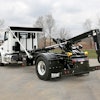
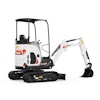
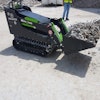
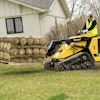
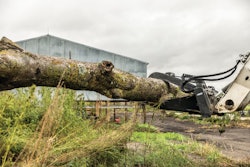



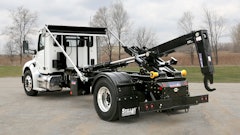
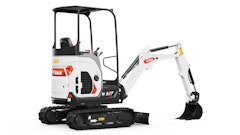
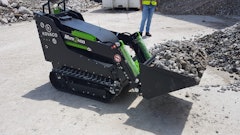
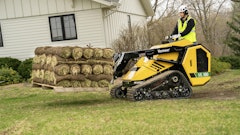


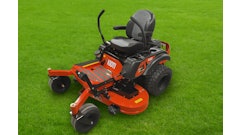
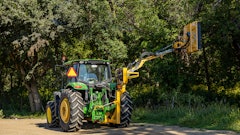
![T708 2025 Ga Tl11 R3 Hr [1 Q5 A1066]](https://img.greenindustrypros.com/mindful/acbm/workspaces/default/uploads/2025/10/t708-2025-ga-tl11r3-hr-1q5a1066.KcuUhTiF78.jpg?ar=16%3A9&auto=format%2Ccompress&fit=crop&h=135&q=70&w=240)
